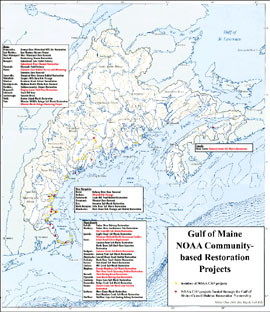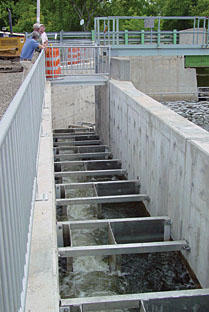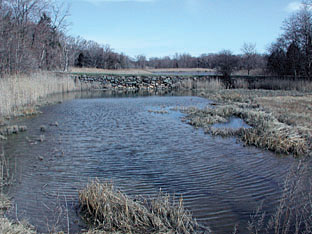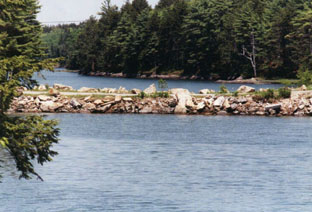|
|
Restoring Coastal Marshes
 |
| Click on the Map to download the high resolution PDF-file. |
In the past 15 years or more, attitudes toward salt marshes and their value have shifted. A growing movement of restoration activities—such as constructing passages to allow fish to swim upstream or out to sea, replacing culverts to bring back natural tidal flow and removing dams to restore vast stretches of a watershed—is taking place from Cape Cod Bay to the Bay of Fundy. While it remains uncertain precisely how many miles of coastal habitat have been restored over the years, a growing body of research, based on the monitoring of rehabilitated sites, is providing clear evidence of the ecological and economic advantages of restoring marshes.
“This is not just a trend,” says Jon Kachmar, the habitat restoration coordinator for the Gulf of Maine Council. “Salt marsh restoration has gained tremendous momentum as more and more communities recognize how beneficial it is to return essential wetland functions back to healthy coastal ecosystems.”
This map highlights more than 50 restoration projects supported, in part, through the National Oceanic and Atmospheric Administration (NOAA) and a NOAA/Gulf of Maine Council grants’ program. In addition to this partnership, a diverse array of local, state, federal and private partners have carried many of these projects through the various stages of site evaluation, project design, permitting and construction.
|
 |
Sebasticook Lake Fishway, Maine
The Sebasticook Lake Fishway is expected to provide access to 4,288 acres of spawning habitat in Sebasticook Lake for alewife. |
 |
Damde Meadows salt marsh restoration, Massachusetts
Two four-foot by eight-foot concrete box culverts, sized to approximate unrestricted, natural tidal flow, have replaced a failing drainpipe that extended below two dikes. |
 |
Dingley Island tidal flow restoration, Maine
In 1946, the bridge connecting Dingley Island to the mainland was removed and filled. Earlier this year, a bridge span was placed in a segment of a causeway, restoring waterflow to 45 acres of clam flats. Photos: Jon Kachmar |
|
Funding programs that support habitat restoration projects
NOAA Community-Based Restoration Program, through partnerships, provides funding and expertise to numerous coastal community projects that promote coastal stewardship and a conservation ethic. For information contact John Catena or Eric Hutchins, National Marine Fisheries Service (978-281-9251).
http://www.nmfs.noaa.gov/habitat/restoration/
Gulf of Maine Council Habitat Restoration Grants Program funds habitat restoration work in states and provinces bordering the Gulf of Maine. For information contact Jon Kachmar at the Maine Coastal Program, Maine State Planning Office, (207) 287-1913 or at jon.kachmar@state.me.us.
Funding Opportunities and Cooperative Initiatives for Habitat Protection, Restoration and Education lists grants supported through the U.S. Fish and Wildlife Service/Gulf of Maine Program and other federal, state and non-government conservation partners. For information contact Sandra Lary, USFWS, (207) 781-8364.
http://gulfofmaine.fws.gov/funding/funding.html
Funding for Habitat Restoration Projects: A Citizen's Guide by Restore America's Estuaries helps individuals, organizations and agencies access federal assistance in support of community-based habitat restoration. You can download the guide by going to The Federal Funding Sources Database, which also provides online access to the funding information provided in the guide
http://restoration.nos.noaa.gov/htmls/resources/funding.html
The EcoAction Community Funding Program an Environment Canada program, provides financial support to community groups for projects that have measurable, positive impacts on the environment including habitat restoration. Submission deadlines are February 1 and October 1 annually.
www.ec.gc.ca/ecoaction
The North American Commission for Environmental Cooperation, an international organization created by Canada, Mexico and the United States under the North American Agreement on Environmental Cooperation to address regional environmental concerns, finances community-based restoration projects.
www.cec.org/grants/ |
|
|

![]()



